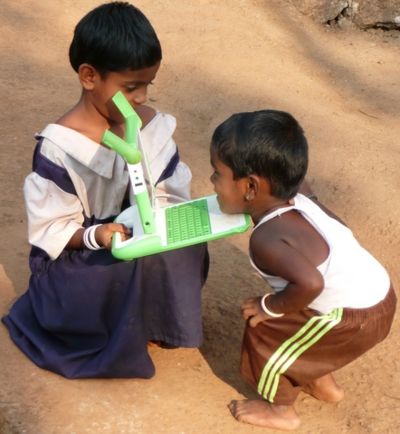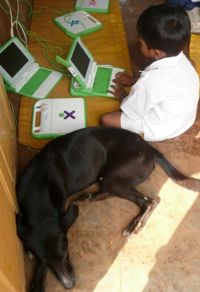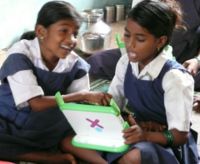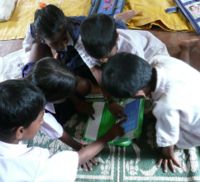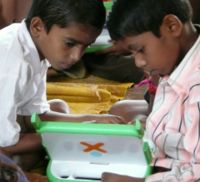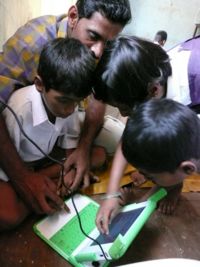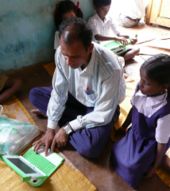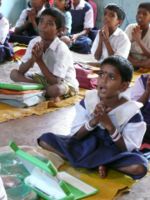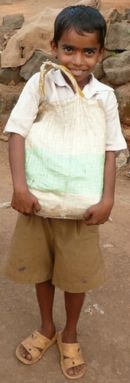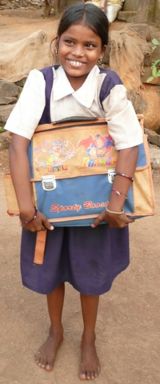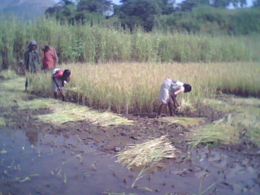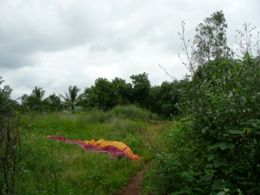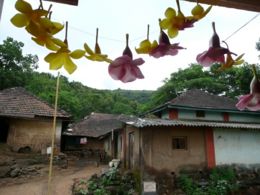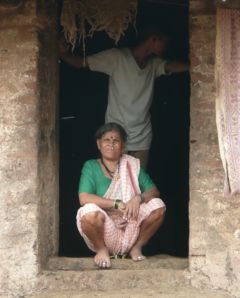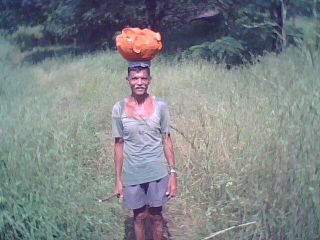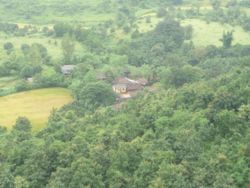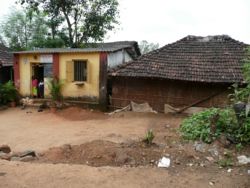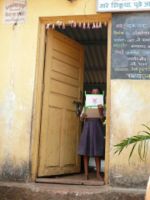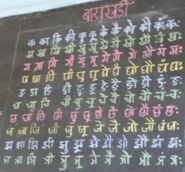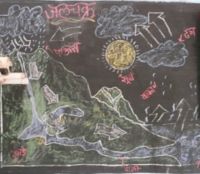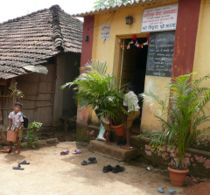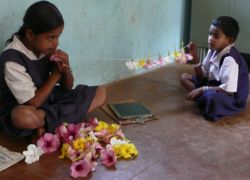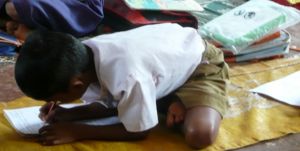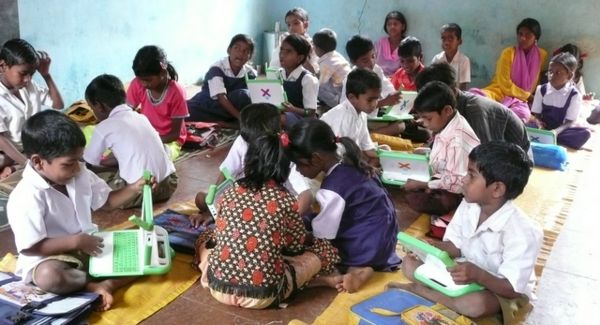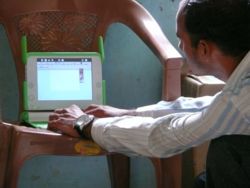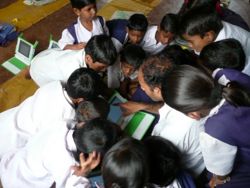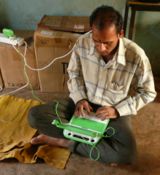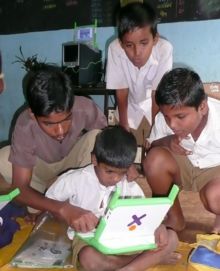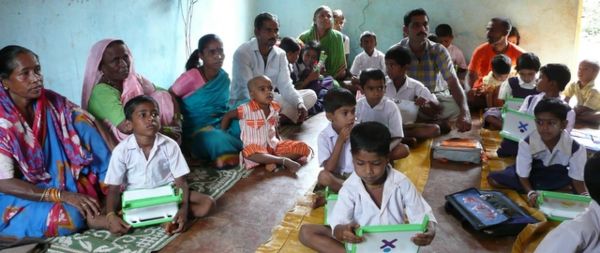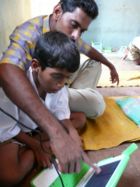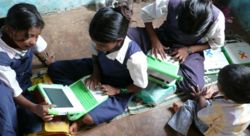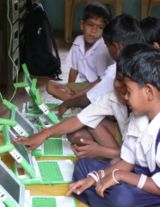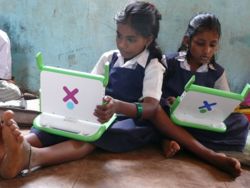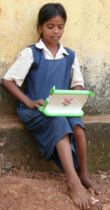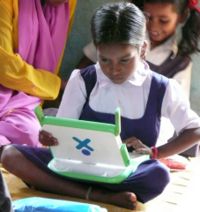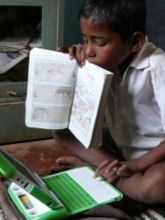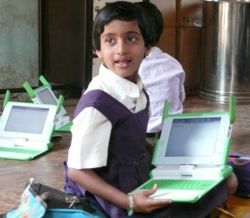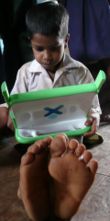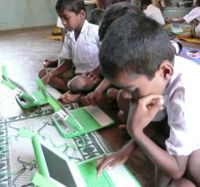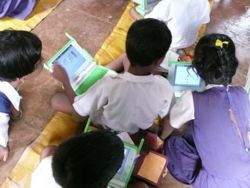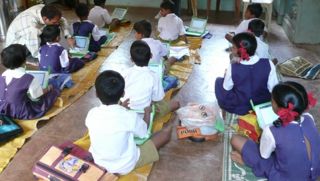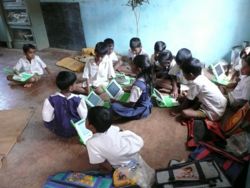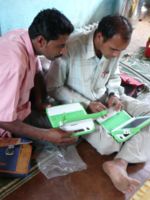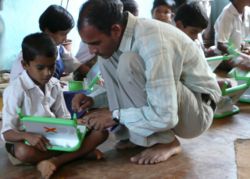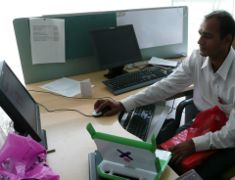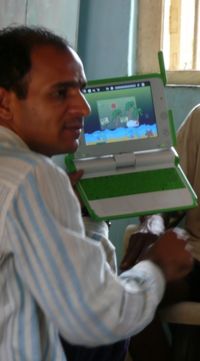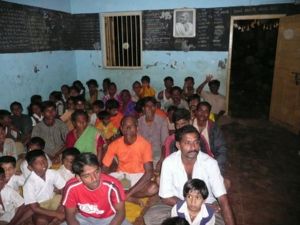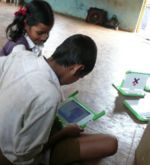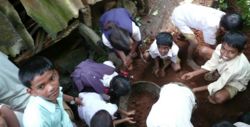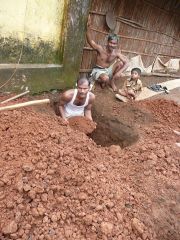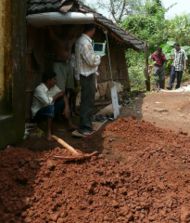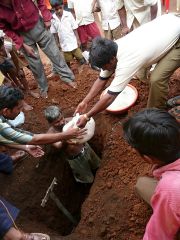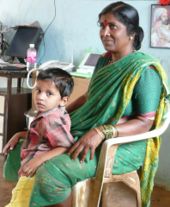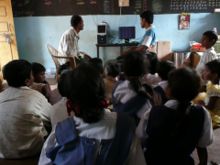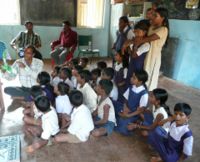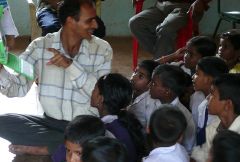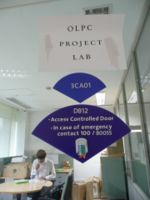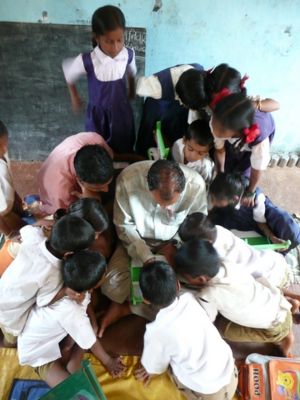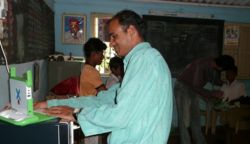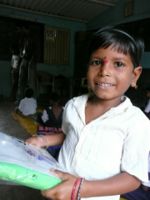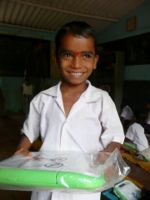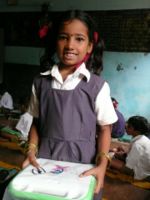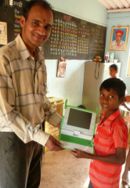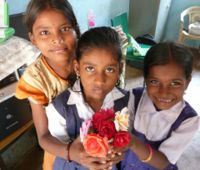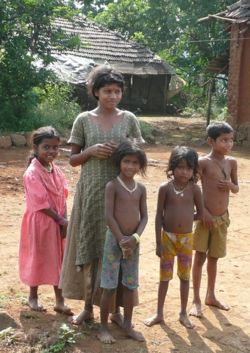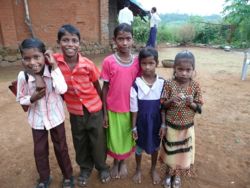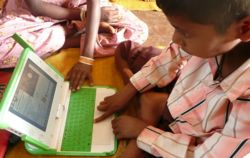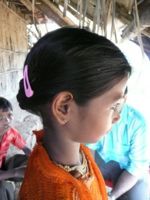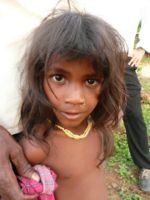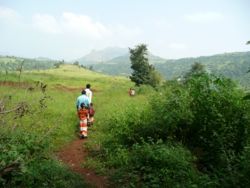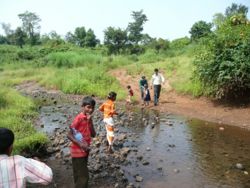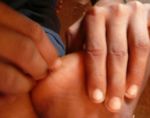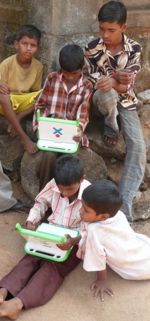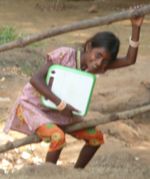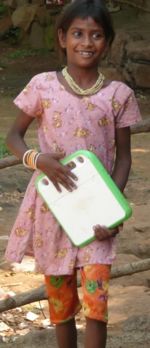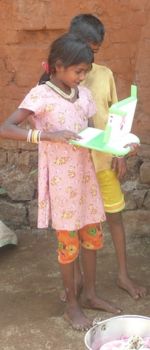OLPC India/DBF/Khairat Chronicle
Ulaanbaatar.mn | Arahuay.pe | Khairat.in | Ban Samkha.th | Galadima.ng | Cardal and CEIBAL.uy | Bashuki.np | Bishwamitra.np | Atlas School.pk | Altos de Cazucá.co [+/-]
Text and Photos by Carla Gomez Monroy, OLPC
Khairat school, OLPC in India: September 26 – October 13, 2007
[Editorial note: The students' names are fictitious.]
October 12th at Khairat school
At the entrance, there was a black dog taking a rest. Beside the dog was Rajiv, in first standard, working on his XO while it was charging, plugged to the outlet on the wall. At the foot of the wall, on a long mat, there were some XOs, being charged.
On the other side of the door, sitting on long, thin mats on the floor, there was a small group of girls and boys working on Etoys. Some were trying out all the sample projects while others were making their own. Among them were Gayatri and Sarasvati, two girls, in third standard, who usually go around the classroom helping others.
Just sitting with their back against the wall, and working on their own on Memorize, were Nandini and Karan. They are a girl and a boy, also in third standard, who are quiet and somewhat shy.
Close to the drinking-water container, were Malini, Mahima, and Vidya singing songs while recording them on Record, and playing them back.
Just behind them and below the window is Sameera taking photos on Record. Next to her, there is a small baby, sitting there, and he suddenly starts crying. Sameera tries to calm him down by patting him on his back while at the same time trying to take more photos. The baby keeps on crying, almost uninterruptedly. He looks very sleepy. After a while, the teacher, comes round and gives him a piece of candy, which keeps him quiet while it lasts, then the teacher asks Sameera to take the baby home.
In the middle of the classroom is Vinod investigating different activities on his XO. Kaushal and Sooraj are exploring eBooks and different links on the Web application.
In the front row, there are Deep, Harihar, and Hridayesh, playing together with Memorize, doing additions. Rohan is close to them typing the Arabic numerals from 0 to 9 on Write, making them big, choosing a color for them, and saying the name of each number in Marathi while pointing at it with his index finger. Then he forgets about the numbers and goes see what others are doing, is interested in Etoys, opens it, and starts drawing, just as some others are doing.
Kamala is exploring her laptop with the help of a few classmates. She got her laptop some time after the other children, the same with her brother, sister and cousin, because they were not coming to school. Everybody is willing to show them how to do this and how to do that. But the children help them learn how to do things by letting Kamala and her siblings do it themselves. Sometimes, the teacher, also sits among the children and explains how to do something on the XO. At times, he brings everybody together and explains the new activity he wants them to do and how to do it. Everybody is 'around' him paying attention, and then everybody goes back to their places to work on it by themselves or in small groups.
Gayatri and Rajiv are siblings, and sometimes they sit together to work something out. Arun learns at a slower pace than others. Sarasvati is Arun's older sister, and she patiently sits with him to explain to him what they have to do and to guide him through the task. Arun is a child with a great heart, who fortunately has the support of his sister, parents, and classmates to learn. Karan also likes to help Arun. And sometimes Arun's father comes to school to work with him, or to sit with the teacher to learn how to use the XO better. Sarasvati also teaches their father how to do things on the XO.
There are also other children that visit Khairat school, who live in the village but are now in 5th standard or higher and therefore attend a school that is farther away. Some teenagers also come a lot and work with the children on the XOs.
The teacher juggles his time with tasks, topics, and children of different ages and grade levels, called standards. He tries to make sure that every child is learning something, that each grade (1st to 4th standard) is moving along. He does it all so naturally that it even seems like if at the same time he is creating and designing new activities on the XO, making simulations of the water cycle on Etoys for the children to see and learn how to do it, and showing them how to write Marathi letters and record the correct pronunciation. And when the Marathi letter that each child drew on Etoys appears on their screens, they each say it aloud, giving as a result many different letters being said or played back at the same time as they say or click on the Marathi font. The teacher also talks to the parents and to the people who come by to visit, or he walks around with his XO while children answer some written task or test. The teacher also takes photos of events he considers important, like the day the hole for grounding the server was made by the locals, and the day we gave the laptops out, and the parents' meetings,....
Time goes by, and suddenly it's already lunchtime. They all put their XOs away, and Sooraj goes out to strike the cymbal. The mats are all picked up (This task is usually done by the boys, other tasks, like fetching water, are done by the girls, though the division of tasks isn't rigorous or inflexible, and the boys may do the sweeping or fetching of water.) The children go out and come back a little later.
Some bring small containers with some curry or masala. A gigantic pot of rice is brought in. The children sit cross-legged on the floor, forming a big square, facing each other. One of the older girls serves the food, and the plates are handed around. The school door is kept ajar to keep the dogs from coming in. The children start eating with their right hands. Some share their own food with their younger siblings who are not registered in school and sit in the inner part of the square. The classroom is quiet while everybody eats. Once everybody finishes, they stand up and drink some water; they also clean their plates with water. Someone sweeps the floor. The mats are put back in their place while the children play for a while outside.
After a while, class starts again and goes on till 5.30 p.m., when the children go home...
Intro
To run the first school implementation with prototype B4 XO laptops in India, we are working with a renowned telecommunications company. Specifically we are working with the Navi Mumbai staff of the company, who for short I will call the Mumbai Team. Following the guidelines I gave them, the Mumbai Team did the magnificent job of locating and establishing a relationship with Khairat school, which was done mainly thanks to Mr. Iyer, who sponsors some schools in the area. The Mumbai Team visited the school and spoke with the teacher about furthering OLPC's mission with his help and that of the children attending the school. And it turned out that they struck a gold mine in terms of kindness and pro-activity of the teacher, children, and community.
Panorama
Mumbai is a big city in Maharashtra state. Its streets are busy with lots of people moving from one place to another, with all kinds of vehicles honking at all times and traveling so close to each other that it seems like at any moment they will collide.
Buildings and shops are all over the island, and the metropolis has outgrown its natural limits and taken over vast expanses of continental land. It's so alive and dynamic.
Around 1.5 to 2 hours away, to the East, is Navi Mumbai, an extension of Mumbai, known as the corporate business area. It is there were the Mumbai Team offices are. Another hour farther East towards Pune is Khairat-Dhangarwada village, in Raigadh district. The monsoon had recently subsided, so once on the highway, the landscape changes from office buildings, production plants, and houses to green fields and hills. After a while, the car takes a two-lane road, and later on, we turn left and take a narrow dirt road. Once the car gets to the end of the road, we get off and walk down a footpath all the way to the village, and to the school.
Khairat is a small village, originated by what once were nomadic tribes, with around 20 houses and 200 people. They settled in that area many years ago, but they still live from their rice crops, chickens, cows, and buffalo.
The houses I visited were spacious and minimalist in their furniture. A section of each house is for the cattle, and a broad hallway connects it to the other rooms of the house. Most of the houses only have outside doors. Inside, there are doorways between rooms, but no doors to open and close. The kitchen ranges are fired with wood sticks. Water is brought by women from the water pump. The houses usually have a partial second floor (like a loft) where people sleep.
Khairat school
Khairat school is a one-room schoolhouse. The land to build it was donated by a villager, who is extremely happy with the idea of having the children of the town educated. I was told that she used to go and help the construction workers with the building of the school. She also came to help organize the digging of the hole for grounding the server. The building itself was sponsored by a villager who has a lot of land in the area. He also supports, on a continual basis, with other items the school needs.
The schoolhouse is 6 years old. Before, thanks to one of the villagers, classes were given in the front room of his house, which is across the street from where the school stands today. The schoolhouse has three cabinets. The one with glass panes is where the children keep their textbooks, and it also contains reading books that children can grab to read. On the top shelf, there is a statue of Ganesha, to whom every day children bring some fresh flowers. In one corner is the water bucket, glasses, and dishes. On the other, is the raw rice bucket and the server cardboard box that sometimes is a desktop for the teacher and other times a table to drink our milky, sugary Indian tea. This arrangement is recent though, because he volunteered his desk for setting up the server.
A broad black strip is painted horizontally across all the walls, on which varied learning stuff is colorfully sketched with colored chalk, such as the Marathi and English alphabets, the water cycle, Mahatma Gandhi's face, the numbers in Marathi,.... Hanging from the ceiling, there's a fan and a few light-bulbs, which are rarely used because the sunlight that comes in through the door and the three grated windows is enough.
The workplace
The first girl to arrive to school early in the morning sweeps the floor. The second girl to arrive helps her remove things from the corners. Other children help by taking out and placing at the entrance two small palm trees they keep inside when the school is closed. The older girls go to the village well for water to refill the water bucket and have water to drink during the day. They also count the rations of rice to be cooked for lunch and take it to the person who will cook it. Three rows are made with mats on the floor. The floor is the seat where the students sit, the surface on which they write, the boundless space they can use to adopt any position they find comfortable as well as to work in pairs or groups, and a classmate—or the teacher—can come and sit next to anyone to help.
There's a plastic chair for the teacher, but when we come, they bring some more from other houses.
School hours
Children go to school from Monday to Friday from 10.30 AM to 5.30 PM (having one hour for lunch from 1.45 to 2.45, and they attend also on Saturdays from 8.30 AM to 10 AM.
Grade levels
The school is multilevel. Children from first to fourth standard take classes in the same classroom with the same teacher. Sometimes they all listen to the same explanation or work on the same assignment, but the teacher usually assigns different tasks to each level, and when the younger ones get stuck and he is busy working with other students, children from third and fourth standard help the first and second standard ones. They learn so much by always being in touch with the 'basics' and previously learned facts, knowledge, or skills, and by teaching others, they reinforce their knowledge. With the XO, they help each other by explaining or by pointing a finger at the screen or keyboard or by checking the work done. And it's not necessarily the older ones who help the younger, nor age or grade level what determines how they group together. You can also see children by themselves, focused on their work, oblivious to what is going on around them, even to what the teacher is saying or doing –and in this case it's totally OK to not pay attention to the teacher.
Although the teacher conducts the activities and is the leader and most knowledgeable one in the room, there reigns an atmosphere of independent work and independent grouping and consultations. The smaller ones are natural scouts and keep on exploring the laptops on their own, and when they find something interesting or need some help, they go to others to show them their findings or be helped out.
Marathi
The people in the village speak Marathi. The teacher speaks some English too. The children and the villagers talk to me in Marathi. I keep the communication channel open by smiling, which is easy and effective. Amit helps a lot by translating.
Regarding the XOs, the children tell me in Marathi what they want to do or what they can't do as they point their finger here and there. I in turn get across to them by showing and doing on the XOs, or by pointing to objects on the screen and keys on the keyboard, and by simultaneously saying and repeating names and actions in English, or in my few words of Marathi that they and Amit have been teaching me. I rely a lot on their goodwill and the context. Even when English and Marathi are so different, even when the keyboard is in English, even when the interface is in English, even when we don't speak each other's language, and even when they are so new to computers, the XO is so user-friendly that I can manage to get across to them, to show them how to do something with it.
And in little time, and having lots of fun, the children of a completely different language are doing this or that on their XOs.
We manage to communicate sufficiently well like that. But Amit helps me when something is really important, like being careful with the XO power adapters that are loose and that the children time and time again keep on adjusting.
The teacher
[Implementation of the OLPC learning approach by the teacher.]
The teacher is a very proactive person. He loves learning and is very committed to OLPC. Everyday he comes with a new idea or a new discovery of how the XOs could foster children's learning in a more fun way.
He is fascinated with the laptop and devotes a lot of quality time to the XO within class and after class. He does small XO activities with the children and guides them through the different phases or lets them find their way on their own, depending....
He also looks after his students' laptops. If there's a problem with one, he reports it immediately. He helps get them charged, and the children with no electricity at home get higher priority charging their laptops in class. (Some go to their neighbors to charge their laptop.)
The teacher also keeps a detailed Journal in a Write file of all the important events since OLPC came to school. He made his student list on the laptop and was appalled when he lost it because we hadn't backed it up on the server. Our fault.
He also likes Etoys to prepare his classes or do projects on it. He takes photos of local views, people, plants and flowers and tags them all. He explores all the software activities and tries to incorporate them to his classes.
The villagers and the sponsors say the teacher is very dedicated and that he's always doing everything he can to give better opportunities to the children.
Older children, teenagers, and villagers
[Active participation of parents and siblings.]
The first day, which was a Friday, when we were giving a laptop to each child, several children that go to another school farther away because they are older came to Khairat school to help. They helped register the XO serial numbers with the names of the children, ordering them by groups, and handing out the XOs. Afterwards, they also helped look over and try out the laptops with the children. They keep on coming, especially during holidays and Saturdays, but once in a while, some have come even on regular school days. They pay attention when we work with the teacher and especially when we look into Turtle or Etoys. They even participate during the problem solving part of the activity, which helps understand or reinforce understanding.
I don't speak Marathi, but I sense that the villagers support the project, including those that don't have children at the school. And everybody is welcome to come and participate. The older children also work on the laptops in the afternoons. I can tell because during the little time they spend with us at school, I've seen that they are becoming better at it.
Some parents have approached the teacher and pointed out that their children don't have a laptop. The teacher explains that it is only for children in 1st to 4th standard but that they are always welcome to come visit Khairat classes.
The villagers
The villagers stop by the classroom often and hang around, especially the ones that are interested in the XOs, mostly young adults who catch on quickly and help explain things to the children, or just explore the XOs with them. There is a young man who comes often and looks into what everybody is doing. If we are explaining something, he adopts a very attentive attitude, and participates. He likes to sit with the children and work with them, and the children go to him to ask him how to do this or that, or to learn how to do whatever he's doing.
Even Mr. Iyer comes to visit us on Saturdays.
Small Parents' Meeting
Oct 3. Mr. Joshi came to Khairat school and organized a small impromptu parents' meeting. Few parents came because of such short notice. Basically, the idea was to explain the project to them and to invite them to take part in the learning of their children. The teacher explained the potential of the XOs in class and of all the relevant stuff that was now at their children's fingertips for them to learn or do, to which they had no opportunity before.
Dedicated father
When the meeting came to an end, a few of the children's relatives stayed behind, among them an older sister and a father to see what it was all about. Though this father had been there the whole morning working with his children, his daughter taught him how to do different things. The father caught on so fast that he moved over to sit with his son to help him out, which lasted a long time. When they wanted to do something new, they would ask the sister again to help or whoever was around. And they continued learning all together. This father kept on coming, once in a while, in the afternoons to work with his children or with the teacher to learn how to do different things on the laptop. He also volunteered some land space for the CowPower project (Arjun’s alternative design).
The students
The students are from 5 to 10 years old. Grade level: primary 1 to 4 or "1st to 4th standard".
In the student list they are around 22 students, though the first weeks I never saw more than 18. Maybe some days some don't come. The teacher says that some children that used to miss school often are not missing a single day now. Though four children still miss school.
Some children who are too shy to talk to the class or to people come often to school, and even if I don't understand them much, they like to work with me, and they help each other a lot.
We have 11 girls and 11 boys registered. The girls in 3rd and 4th are the ones who help the 1st and 2nd students a lot.
The youngest children are always exploring the XOs and are getting very good at it. There are two siblings, one in 1st standard, who is 5 years old and his sister in 3rd standard. They both are really good with the laptop. She helps her classmates because she grasps things fast. And he likes to do things on his own. Nevertheless, he also likes people explaining to him how to do new things, but it's got to be him doing the clicking and key punching.
The numbers they know are also in Marathi, which are somehow different to the Arabic/Latin ones we use in English, but they still try and like the Memory game.
Before school or after school, when we got together to work with the teacher, children would come quickly to school and work on their XOs, while we were working with the teacher.
Teacher session
October 2, Mahatma Gandhi holiday. Children had finished school early and were already on their way home when we arrived. Most of them stopped on their tracks when they saw us and started running back to school. Then more children joined the race back.
The plan was to just work with the teacher. However, as soon as he got his students back in school, the teacher started working with them and teaching them how to write their names in English and how to do several other things on the laptops. Then, after a while, the teacher sat to work with me.
Around noon or 1 p. m., one or two of the students asked for permission to go have lunch. Even after the teacher told them they could all go home, they stayed all the time we were around. If their laptops ran out of charge, the children would work with other classmates while theirs were charging or they would sit close to the power outlets to keep on working.
We would work in the mornings before class started or while the children were busy doing something, also on Saturdays, after school. And one Sunday, the teacher came to the Navi Mumbai offices to work on everything related to the Internet, because at school the connection was super-slow, back then.
The work with the teacher was on how to best use laptops as a tool to “learn learning” by expressing, constructing, designing, modeling, imagining, creating, critiquing, debugging, collaborating with the children, carrying out hands-on activities and project based work, retrieving specific data from the Internet, and publishing content and collaborative production of content on Wiki pages shared on the Internet. We also went into XO software activity potentials and into applying learning in educational projects that raise children's awareness about their environment, in a local and global context. And throughout, we worked on integration of the curricula with the software learning activities, by children and teacher.
Project-based learning
On October 2nd, I worked with the teacher on what Project-based learning is, among other topics.
(A note on our communication: During our first week working together, the teacher was a little bit shy about his English. Later he would even translate other people's conversations in Marathi. But in those first days, we didn't know whether we were understanding each other or not, so we used a lot of sketches and examples to explain ourselves and wrote down the main ideas.) So after a long session on project-based learning, I was not sure how clearly I had passed on to him the whole idea. But he had homework....
On the following day, this is [an excerpt of] what he showed up with:
Project topic: Trees
He started with:
- What's a tree? Its parts, kinds, the ones that children have at home, the fruits and products that come from trees, the different kinds for different uses (furniture, curative uses, food,...) Why trees are good for us and for the world. How they grow. Pollination. Photosynthesis. How to take care of them. Why and how to take care of them. Water cycle
- Experiments with growing flowers of different colors or taking care of a small plant, to understand the CO2 cycle
- Kinds of trees depend on the ecosystem, by area, by temperature,....
- Children can count kinds of trees, or number of trees in town. And do different problem sets related with trees.
- Newton's law of gravity came from an apple that fell from a tree, to get into physics
- Mahatma Gandhi's analogy of religion being like a tree.
- Deforestation, ozone layer,
- Regulations and legislations of the government about trees,
- Government, NGO's and other initiatives doing something about trees
- and many more
I was impressed both with how well he had understood the multidisciplinary idea of projects and how to integrate them with the curricula and with how well he synthesized and put together the whole thing. But that's not all: he had even started doing some animations in Etoys to illustrate the water cycle.
Parents' meeting
We had a parents' meeting one Monday evening. We had scheduled it for 7 p. m., but due to a meeting we had at Navi Mumbai we arrived late. It was already dark, and some parents were waiting for us with flashlights and cell-phones to illuminate our walk down the path. At the school, there was no other source of light that evening, and everything was pretty dark. The meeting, however, was wonderful. The attendance was impressive (even the teacher said so). Most parents, grandparents, siblings, and other children, even Mr. Deepak, were there, except for Garima, Kamala, and Vinod’s and Sanjey’s parents, who had just left because for them it was a long walk in the dark to get to their village and home). Mr. Joshi lead the meeting as representative of our Mumbai Team.
Grounding the server
One Saturday was devoted to ground the server. It became a community event. We came with two electricians from Navi Mumbai and the metal plates. They had started a hole on one side of the school but it was too small, so they started another one in front of it. The men of the village took turns to dig the hole. People gathered around to watch, chat, and enjoy the day in each other’s company. Tea was brought. Children were playing and carrying dirt from one side to another just for fun, and they brought a couple of plants from ‘somewhere’ to plant in the first hole. The hole had to be 3 meters deep, and before putting the salt into it, someone brought a coconut and some incense to bless the hole or something like that. Then the metal plates were lowered, and the hole was filled up with the soil by all the people around. After the grounding was done and the electrician had also fixed the wall outlet, the server was turned on. All the children sat around the server and the villagers that had helped stood at the back, waiting to see what would happen next. The Linux server started its activity on the black screen and white fonts quickly flashed in one by one and scrolled up. Everybody patiently waiting.
We opened and switched on two XOs and they wirelessly connected to the Internet. With one we explored the OLPC Wiki page, and everybody was very happy to see a photo of Khairat school’s cymbal on the screen. Then the teacher looked into some other links and translated for the children and the people around. Then the Internet signal became too slow. That was when we realized we needed another Internet solution, since the cell-phone signal was too slow.
The Team
The Mumbai team (OLPC-India team):
There are in fact two teams. The composition of the team in the field is different from that of the strategic team, but the dividing line is so thin that I will not stress the difference.
- The strategic team (July – to date), stationed at Navi Mumbai, did wonders to get things going, make things happen at the school, and for OLPC-India in general.
- Mr. Joshi (July – to date) is part of the strategic team, but he came to school with us a couple of times for the parents' meetings. He always spoke to the villagers and the teacher about OLPC and its relevance to their children’s learning, and about the importance of the villagers’ involvement, as well as about our role.
- Amit (Sept. – to date) has a technical background: Linux. Although, he quickly learned and helped nicely on the educational side, and naturally did a great job on the community side. He simultaneously collaborated in the three areas, and now he is following up also with the educational and community aspects besides doing so with the technical aspect at the school, with lots of support from the strategic team.
The OLPC team:
- Carla (Sept. 26 – Oct. 13) Mainly worked on the educational side of the project, but also did so on the technical side and community relations (all of which goes together anyway) with few words but lots of positive feelings.
- Arjun (Oct. 4 – 10) Worked on the network testing with Manu and Amit, Marathi fonts with Amit, various bugs, individual solar panel readings, designed the CowPower project (Amit helped with the implementation and follow up).
- Manu (Oct. 4 – 8) Worked on the network testing with Arjun and Amit, and looked into some other technical aspects.
The OLPC team keeps providing long-distance support to the Mumbai team and Khairat school.
Extra bits & pieces… or wholes?
When OLPC first arrived to Khairat
The day before I arrived to Khairat, our Mumbai team had come to school to meet the teacher and also to leave five XOs. I came for my first time to Khairat school on a Wednesday. I loved it. The children, the teacher, and the villagers were shy with me, but still I sat among the children to work in groups on the five laptops we had with us.
We spoke with the teacher mainly through Amit's translations We talked about the timeframe for my visit and the OLPC educational approach in general. He showed me all the things he had already worked on in a couple of sessions he had had with our Mumbai team in their Navi Mumbai offices. It was excellent groundwork.
On Thursday, we came to school in the afternoon with all the XOs, one for each child. And on Friday, morning, with the help of many young villagers, we handed out the XOs to them. Amit was the master of ceremonies in Marathi, and it took like two hours from the time we started until every child had a laptop. Each child had to come to the front, and Amit would ask something adequate for their grade level, like tell me the ABC's or the Marathi numbers. They all answered correctly right away.
Every morning and once in a while during the rest of the day, I would receive a beautiful flower from the hands of a child. Flowers were brought every day. Two girls would sit on the floor to make a flower line to hang on the door. Ganesha was the first to receive some flowers, and all the children, teacher, and visitors would also receive one, as well as all the portraits on the wall, which of course included Gandhi's.
Every morning we would drink some sweet milky tea that was brought to school, or we would be invited to go a villager's home to drink it there. At the beginning it was more common to drink tea at school, but gradually it became more common to have it with a family in their home. 'We' learned many things from those visits, but considering my Marathi, 'I' did much of the learning after we had left, when I was briefed in English on what was said.
It was a very hot and humid season, so we drank water brought by the children from the village well.
Every child at school
One day, the teacher told Arjun about the four students that were not coming to school. So, the following day we asked the teacher for details. The teacher explained that from the school it was about a 20-minute walk to the children's home, which was in another small village, that their parents didn't motivate them much to come to school, and that every day he used to go to their home to bring them because it was more or less on his way to school, since he lived even farther away. But going to bring them meant chasing them all over the fields. So he stopped going. But, he said, it was a shame because they were very smart.
Since those children were officially registered at Khairat school, we thought they should get their XOs, whether they came to school or not. However, a little bit of pushing would do them no harm, and it would do them a lot of good if we managed to get them to come to school and discover the joy of working with the OLPC approach. So we made a plan to invite their parents to our parents' meeting on Monday. So first thing Monday, the team split up (Arjun and Amit went to Mumbai to look for parts and Manu and I went to Khairat school). We picked up the teacher on our way, as usual, and on the way we ran into Deepak, a wise and rich neighbor from that village with some influence on his neighbors. He went with us to look for them. After a little while of going down the dirt road, we saw some children running and playing in the field, and the teacher said, there they are. But by the time we got to their home, nobody was around. So now I had a better idea of what the teacher meant about the parents and having to chase the children. We looked for their neighbors, we went inside the houses that were open, but nobody was around. After a while, one of the older sisters showed up, carrying water on her head, with some of the younger children. We were told that their mother was doing the laundry, so we went across the fields and walked into the river and upstream until we found her with one of the girls.
The teacher invited them to come to the meeting, and then we walked from there to school.
The next morning, Amit, the teacher, and I went to their house again. Arjun had gone to Mumbai again and Manu had gone back to Delhi. Amit did a lot of talking with the parents, the children, and everybody around. The teacher had told us which ones were the children. The four children, when they saw the teacher, had gone to change their clothes to come to school. I played with all the children, then Amit and the teacher joined us in the game. After a while of talking with everybody, Amit said we were going on a picnic. So all the children that were there rode in the SUV with us. We drove not far away from school to a local restaurant. All the way all the children were singing and screaming, very happy about the ride. We had some local food and then we all went to school.
All the class welcomed the children, and they made small groups to introduce them to the laptops. It was great to see Kaushal teaching Vinod the same way we did. He would explain and some times point where to click, but he would let Vinod do it all. All the others were very keen on working with the newcomers, except for Rajiv who was so into his own exploring that nothing could distract him. Rohan pointed out that Rajiv was not helping others. Rajiv didn't care, maybe didn’t even listen. But for some reason, a little while later he joined a group to play memory with them. The older siblings stayed with us for a while, also working with the small groups and later left.
At school, Kamala and Garima were more on their own. Garima was obviously considering going back home and Kamala was trying to convince her to stay. We played with all the children and then they went back to classes.
Kamala, Garima, and Vinod are siblings. Sooraj is their cousin. Sooraj is a very smart boy, who in spite of having missed school a lot, remembers most of what he learned.
Wednesday, Arjun, Amit, and I also went to pick them up in the morning. This time we came earlier, and they were not ready. When they saw us, they changed their clothes, and I helped do Kamala's, Garima's and the smallest sister's hair.
That day we walked the path they usually walk to school. This time we had some bananas and biscuits for a picnic on the road, which took place not far from their house, in the yard of Deepak, who invited us to have a cup of tea. The sun was already shining strongly when we walked to school. We all enjoyed the walk. Some of them walk barefoot. I many times was barefoot, like them, except that at times like this I had to instinctively skip from here to there because I felt the floor burned like a red hot pan. They were completely OK with the ground and probably found my walking style very funny.
The teacher had gone to some examinations to another school, and there was no power at school when we got there. We charged one laptop with our individual solar panel. Some children who had charged through the night worked on their XOs. And all the others were playing games with us. School was over early that day. Arjun left to Delhi. Amit and I went to Mumbai to follow up on the assembly of CowPower and to get some extra parts.
Thursday – We could not come to school because of a press conference in Mumbai.
On Friday morning, we went to pick up the CowPower apparatus to Mumbai, so we arrived after lunch to school. Amit noticed that Kamala and Garima were absent, so he went with Sooraj and Vinod to bring them from their home. They walked. They returned only with Kamala. They said that Garima cried and refused to come to school.
Kamala was crying because she had a thorn on her foot. Sameera removed the thorn from Kamala's foot with a knife and a pin. It was impressive because in doing so she cut a little piece of the hardened sole of Kamala's foot, no raw flesh, no bleeding at all. Kamala stood up and started playing with other girls.
Saturday. We went straight to school. Kamala, Sooraj, and Vinod were working with the other children very happily. Since Garima was absent I went to pick her up. Amit was busy with the high speed Internet providers, so I decided to go by myself. When I got there and Garima saw me, she totally understood that I had come to take her to school. She didn't run away, but she wouldn't look at me. She was just standing against the wall. I invited her to come to school, but she just stood there. An older sister was with me, and I asked her to bring her some clothes. I accompanied what I said in English with hand gestures. Garima didn't want to dress on her own nor to be helped by her sister. Garima left and went into a hut, farther away. I sat there to wait. The sister stayed there with me. Then other children began to play with their blowguns, and I tried it too, but I was not good at it at all. They found it funny. The problem was that something got stuck inside, so they went to the hut where Garima was to ask the older boys to help them. They unplugged it right away, and then I challenged them to hit difficult targets. They turned out to be great shots, and we laughed every time they hit or missed their targets. Meanwhile, Garima had gotten dressed on her own. While I was sitting there, the sister started doing my hair. Then, she stood up and did Garima's hair. After which, I asked Garima if she was ready, and all the children escorted us to the car. She didn't want to ride on the copilots seat, nor in the back seat with me, so we opened the back and put the two seats there. But still she was serious and didn't want to get in. The driver asked the children that were there to come along with us, so she would feel better. Most of the children chose the cool seats, and Garima rode with the others in the back. On the way, near the school we ran into many more children coming to town from their school, so we stopped to also give them a ride. The car was packed, but still we all fit in, and sang, and screamed very happily. Garima was still serious. Finally, we arrived at school.
It was a very hot day, and some were working on their XOs in the shade. We had a small farewell reunion with traditional sweets and some words from the teacher, because it was my last day. Lunch was brought into the classroom for the children. Vinod, Sooraj, Kamala and Garima went back home at that moment, with a solar panel. We kept Garima's XO to upgrade it.
On our way back, we dropped off Garima's laptop, already upgraded. She was smiling and even said “bye” together with all the children.
Acknowledgements
- Thanks to Amit for providing or verifying many details that I needed for this chronicle, including the fictitious names. All mistakes are mine, though.
- Thanks to each and every member of the Mumbai Team for their efficient work and for the pleasurable company and teamwork.
- Thanks to all the children, the teacher, and all the community of Khairat school.
- Thanks for the support provided by all the OLPC people working behind the scenes.
--Carla 15:02, 30 October 2007 (EDT)
